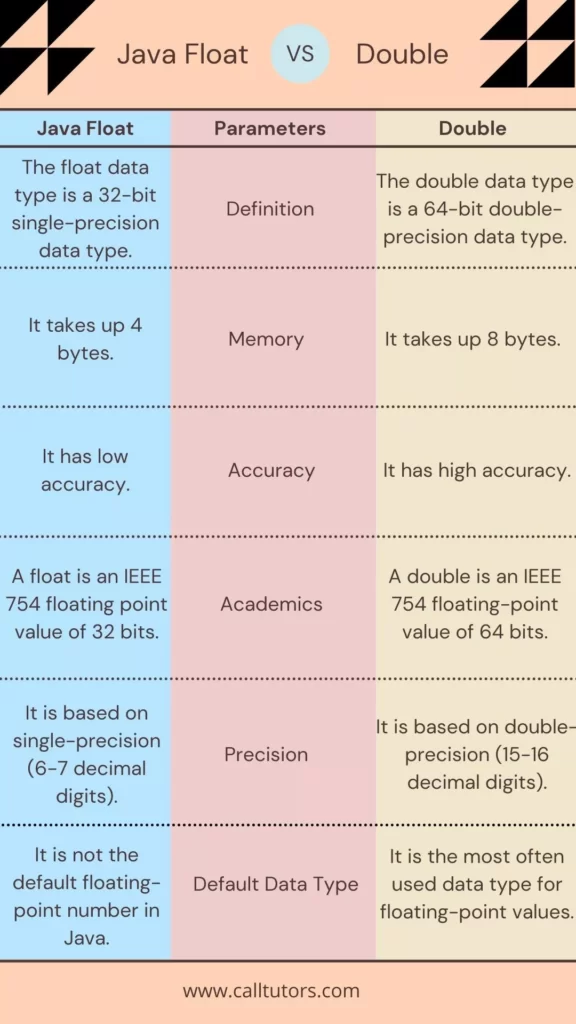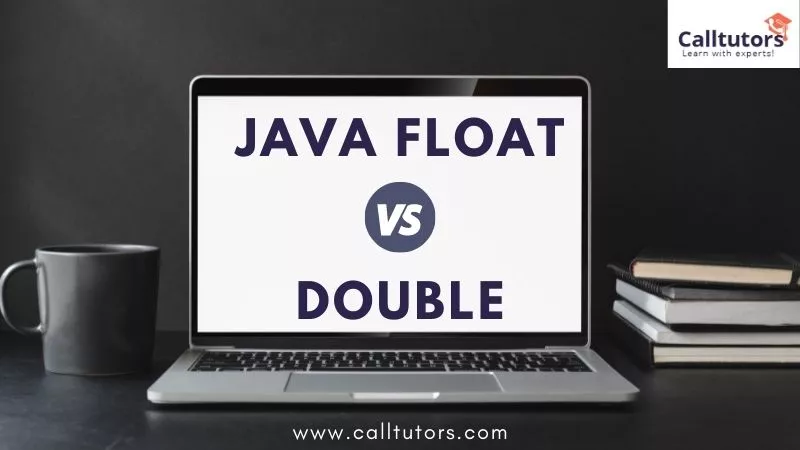Are you interested in knowing about some key differences between Java Float vs Double? If yes, then you are at the right place. Java Float vs Double is always a big concern among the students. Before going deeper, Let’s start with a short introduction to each of these terms.
What is Float & Double?
Table of Contents
Data is broadly classified into two types: numeric data and non-numeric data. Characters and strings are examples of non-numeric data. Numeric data is made up of both whole numbers and floating-point values. Whole numbers, as the name implies, only have a whole portion – no fractions are involved.
Floating-point numbers, on the other hand, are pre-programmed with a fractional and a whole portion. Whole numbers are allocated multiple data types based on the magnitude of the data requested, which may then be utilised as needed. Similarly, based on the size of the number – particularly the fractional element – floating-point numbers might be allocated to multiple data types. Float and Double are two terms that are used to represent floating-point numbers.
Java allocates two data types for dealing with floating-point numbers: float and double. Both data types are basic in nature, which means that their definitions are part of the language itself. Why are two data types assigned to perform the same function? They differ greatly in terms of range and applicability in various contexts.
When to use Float and Double in Java?
When speed is more critical than accuracy, float is commonly used. While our day-to-day programmes do not require massive computations, this gap becomes fairly important in practical applications. Floats are also commonly used when the number of decimal digits required is known. In practically all other circumstances, double is utilised, especially where accuracy is critical. Keep in mind that when working with floating-point values, Java requires the usage of double as the default data type.

Some Important Similarities Between Float and Double Data Type
- Both data types can represent real values.
- As float and double data types are not accurate, their values are approximate.
Some Small Differences Between Java Float vs Double
Float is a single-precision 32-bit IEEE 754 floating-point data type. The range of values is outside the scope of this study, however it is primarily stated in the Java Language Specification’s Floating-Point Types, Formats, and Values section.
The double data type is a 64-bit double-precision IEEE 754 floating-point data type. Its value range is outside the scope of this study, although it is stated in the Java Language Specification’s section on Floating-Point Types, Formats, and Values.
A float is mostly utilised in huge arrays of floating-point integers to conserve memory. We must always keep in mind that data types should never be utilised for exact quantities such as currency.
For decimal numbers, the double data type is usually the default. Never use the data type for accurate values, such as currency.
Java Float vs Double: Default Values
In Java, the float data type records a decimal value with 6-7 total digits of accuracy. So, for example, 12.12345 is a float that can be preserved, but 12.123456789 is not. When expressing a float data type in Java, the letter f should be appended to the end of the data type; otherwise, it will save as double.
The double data type records decimal numbers with a precision of 15-16 digits. The default value is 0.0d, which implies that if you don’t attach f or d to the end of the decimal, Java will save the number as a double.
| Data Type | Default Values (For Fields) |
| Float | 0.0f |
| Double | 0.0d |
Java Float vs Double: The Essential Differences
There are so many differences between Java float and double that are essential ones and some of them are the following points describe the major difference between float and Double in Java:
- In Java, the double data type is more accurate than the float data type. In Java, floating-point numbers are double by default. To save them in the float variable, you must explicitly cast them or suffix with ‘f’ or ‘F’.
- Float utilises one bit for the sign, eight bits for the exponent, and 23 bits for the mantissa, whereas double uses one bit for the sign, 11 bits for the exponent, and 52 bits for the mantissa.
- There are some essential factors to consider while deciding between Java float and Double. We may also encounter instances when we need to utilise a certain data type, until and until you believe that your result will not fit in float, in which case you can use double.
- Both Java float and Double are approximations, although they differ in memory space and other ways.
- When comparing java and float, always use Big Decimal, and when working with Big Decimal constructors, use with a string parameter.
Java Float vs Double: In Tabular Form

| Basis For Comparison | Java Float | Double |
| Definition | The float data type is a 32-bit single-precision data type. | The double data type is a 64-bit double-precision data type. |
| Memory | It takes up 4 bytes. | It takes up 8 bytes. |
| Default Data Type | It is not the default floating-point number in Java. | It is the most often used data type for floating-point values. |
| Accuracy | It has low accuracy. | It has high accuracy. |
| Academics | A float is an IEEE 754 floating point value of 32 bits. | A double is an IEEE 754 floating-point value of 64 bits. |
| Precision | It is based on single-precision (6-7 decimal digits). | It is based on double-precision (15-16 decimal digits). |
| Data Loss | If we convert float to double, there will be no data loss. | If we convert double to float, we will lose data. |
| Keyword used | A float number is defined using the float keyword. | A double-precision number is defined using the double keyword. |
| Representation | 28.96f or 28.96F | 12.5 or 12.5D or 12.5d |
| Uses | It should be utilised when less precision is necessary and storage space is limited. | It is employed where greater precision is required as well as greater accuracy. |
| Wrapper Class | The wrapper class of it is java.lang.Float. | The wrapper class of it is java.lang.Double. |
| Suffix | It employs the suffix F or f. If you are declaring a float variable, you must provide a suffix. | It has a suffix of d or D. If you are declaring a double variable, you may or may not use a suffix. |
| Range | When compared to double, float has a narrower range. | The range of double is greater. |
| Storage | The float requires 32-bit storage (it only takes four bytes to store a variable). | Double need 64-bit storage (It takes 8 bytes to store a variable) |
| Benefits | It has extensive support libraries. Open source and community development. | It has more web development and web-focused features. |
Conclusion: Java Float vs Double
In this blog, we have discussed Java Float vs Double. And, for the students to understand the essential differences between the terms Java Float vs Double is very helpful. But if in any case, you need assistance regarding Java Homework Help then feel free to contact us. We are always available to help you.
FAQs Related To Java Float vs Double
Should I use float or double?
Double is more precise than float and can stores 64 bits, which is twice as much as a float. We use double over float for storing huge numbers because it is more exact. In most cases, unless we need precision up to 15 or 16 decimal points, we can remain with float because double is more expensive.
Is float faster than double Java?
Floats are faster one than doubles when you don’t need double precision, you’re memory-bandwidth constrained, and your hardware doesn’t penalize floats. They save memory bandwidth since they take up half the space per number.



